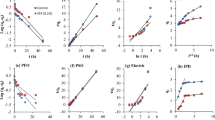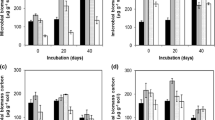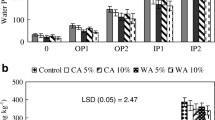Abstract
Ashes produced during on-farm burning of crop residues are mixed in soil before sowing next crop and studies suggest that they can enhance adsorption of pesticides in soil. Enhanced adsorption of pesticides in soil can reduce their availability for degradation and pest/weed control. Therefore, present study evaluated effect of sugarcane trash ash (STA) on degradation of atrazine (used to control annual grasses and many broad-leaved weeds) and fipronil (used for control of early shoot borer and termites) in three sugarcane growing soils and bioavailability of atrazine. Three sugarcane-growing soils (silty clay loam, sandy clay loam and loam) were used to study effect of 0.1 and 0.2% STA on atrazine and fipronil degradation in laboratory incubated soils. Field study for effect of STA on atrazine degradation was performed in silty clay loam soil. Effect of STA on atrazine bioavailability was assayed using its effect on mustard seed germination. Pesticides and their metabolites were quantified using high-performance liquid chromatography (HPLC)/ gas–liquid chromatography (GLC)/ liquid chromatography-mass spectroscopy (LC–MS/MS). Under laboratory condition 0.2% STA doubled atrazine half-life (t1/2) in sandy clay loam, increased t1/2 by 40% in silty clay loam, while no significant effect was observed in loam soil. The STA did not affect fipronil degradation in all three soils. Metabolites, hydroxyatrazine and deethylatrazine (atrazine) and sulfide, sulfone, amide and desulfinyl (fipronil) were detected in soil samples; but their spectrum and quantities varied with the soil type. The t1/2 of atrazine under field condition was 3.61, 2.73 and 2.86 days in control, 0.1% and 0.2% STA-mixed silty clay loam, respectively. The STA reduced atrazine availability suggesting that higher amount of herbicide will be needs for the desired effect in STA-mixed soils. This study has relevance in assessing fate and bioavailability of atrazine and fipronil in sugarcane soils where trash is burnt year after year and mixed in soils. The STA mixing might have cumulative effect due to regular burning of trash.


Similar content being viewed by others
References
Bang-Andreasen, T., J.T. Nielsen, J. Voriskova, J. Heise, R. Rønn, R. Kjøller, H.C.B. Hansen, and C.S. Jacobsen. 2017. Wood ash induced pH changes strongly affect soil bacteria numbers and community composition. Frontiers in Microbiology 8: 1400. https://doi.org/10.3389/fmicb.2017.01400.
Basu, M., M. Pande, P.B.S. Bhadoria, and S.C. Mahapatra. 2009. Potential fly-ash utilization in agriculture: A global review. Progress in Natural Science 19: 1173–1186.
Chatterjee, N.S., and S. Gupta. 2010. Fipronil mobility and transformation in undisturbed soil columns. Bulletin of Environmental Contamination and Toxicology 85: 152–156.
Deokar, S.K., S.A. Mandavgane, and B.D. Kulkarni. 2016a. Adsorptive removal of 2,4-dichlorophenoxyacetic acid from aqueous solution using bagasse fly ash as adsorbent in batch and packed-bed techniques. Clean Technologies and Environmental Policy 18: 1971–1983.
Deokar, S.K., S.A. Mandavgane, and B.D. Kulkarni. 2016b. Agro-industrial waste: A low cost adsorbent for effective removal of 4-chloro-2-methylphenoxyacetic acid herbicide in batch and packed bed modes. Environmental Science and Pollution Research 23: 16164–16175.
Deokar, S.K., D. Singh, S. Modak, S.A. Mandavgane, and B.D. Kulkarni. 2016c. Adsorptive removal of diuron on biomass ashes: A comparative study using rice husk ash and bagasse fly ash as adsorbents. Desalination and Water Treatment 57: 22378–22391.
França, D.A., K.M. Longo, T.G. Soares Neto, J.C. Santos, S.R. Freitas, B.F.T. Rudorff, E.V. Cortez, E. Anselmo, and J.A. Carvalho Jr. 2012. Pre-harvest sugarcane burning: Determination of emission factors through laboratory measurements. Atmosphere 3: 164–180.
Giori, F.G., V.L. Tornisielo, and J.B. Regitano. 2014. The role of sugarcane residues in the sorption and leaching of herbicides in two tropical soils. Water Air & Soil Pollution 225: 1935. https://doi.org/10.1007/s11270-014-1935-8.
Govantes, F., O. Porrúa, V. García-González, and E. Santero. 2009. Atrazine biodegradation in the lab and in the field: Enzymatic activities and gene regulation. Microbiology and Biotechnology 2: 178–185.
Hiller, E., M. Bartal, J. Milicka, and S. Cernansky. 2009. Environmental fate of the herbicide mcpa in two soils as affected by the presence of wheat ash. Water Air & Soil Pollution 197: 395–402.
Hillier, J.L., T.H. Fletcher, M.S. Solum, and R.J. Pugmire. 2013. Characterization of macromolecular structure of pyrolysis products from a Colorado green river oil shale. Industrial & Engineering Chemistry Research 52: 15522–15532.
Jain, N., A. Bhatia, and H. Pathak. 2014. Emission of air pollutants from crop residue burning in India. Aerosol & Air Quality Research 14: 422–430.
Kumar, A., and N. Singh. 2020a. Effect of crop residue ashes on sorption behavior of herbicides used in the succeeding crop in Indian soils. Journal of Environmental Science & Health B55: 630–645.
Kumar, A., and N. Singh. 2020b. Crop residue ashes reduce leaching, persistence and bioavailability of sulfosulfuron and pretilachlor used in the succeeding crop. Soil Research 58: 551–560.
Kumar, A., A. Mandal, and N. Singh. 2019a. Rice and wheat straw ashes: Characterization and modeling of pretilachlor sorption kinetics and adsorption isotherm. Journal of Environmental Science & Health B54: 303–312.
Kumar, A., N. Singh, T. Banerjee, and S.B. Singh. 2019b. Chemical degradation of sulfosulfuron in aqueous suspension of rice and wheat straw ashes. Bulletin of Environmental Contamination and Toxicology 103: 484–489.
Kumari, U., T. Banerjee, and N. Singh. 2021. Evaluating ash and biochar mixed biomixtures for atrazine and fipronil degradation. Environmental Technology and Innovation 23: 101745. https://doi.org/10.1016/j.eti.2021.101745.
Loganathan, V.A., Y. Feng, G.D. Sheng, and T.P. Clement. 2009. Crop-residue-derived char influences sorption, desorption and bioavailability of atrazine in soils. Soil Science Society of America Journal 73: 967–974.
Nel, P.C., and C.F. Reinhardt. 1984. Factors affecting the activity of atrazine in plants and soil. South African Journal of Plant and Soil 1: 67–72.
Pandey, V.C., and N. Singh. 2010. Impact of fly ash incorporation in soil systems. Agriculture Ecosystem and Environment 136: 16–27.
Sheng, G., Y. Yang, M. Huang, and K. Yang. 2005. Influence of pH on pesticide sorption by soil containing wheat residue-derived char. Environmental Pollution 134: 457–463.
Singh, N., S.B. Singh, and T.K. Das. 2013. Effect of fly ash on persistence, mobility and bio-efficacy of metribuzin and metsulfuron-methyl in crop fields. Ecotoxicology and Environmental Safety 97: 36–241.
Trivedi, N.S., S.A. Mandavgane, and B.D. Kulkarni. 2016. Mustard plant ash: A source of micronutrient and an adsorbent for removal of 2, 4-dichlorophenoxyacetic acid. Environmental Science & Pollution Research 23: 20087–20099.
Turner, J.A. 2015. Pesticide manual. Worcestershire: British Crop Protection Council.
Yadav, S., and N. Singh. 2020. Sugarcane trash ash: A low cost adsorbent for atrazine and fipronil removal from water. Indian Journal of Chemical Technology 27: 319–325.
Yadav, S., and N. Singh. 2021. Increased sorption of atrazine and fipronil in the sugarcane trash ash–mixed soils of northern India. Journal of Soil Science and Plant Nutrition 21: 1263–1276.
Yang, Y., and G. Sheng. 2003. Enhanced pesticide sorption by soils containing particulate matter from crop residue burns. Environmental Science & Technology 37: 3635–3639.
Yang, Y., G. Sheng, and M. Huang. 2006. Bioavailability of diuron in soil containing wheat-straw-derived char. Science of Total Environment 354: 170–178.
Yang, X.B., G.G. Ying, P.A. Peng, L. Wang, J.L. Zhao, L.J. Zhang, and H.P. He. 2010. Influence of biochars on plant uptake and dissipation of two pesticides in an agricultural soil. Journal of Agricultural and Food Chemistry 58: 7915–7921.
Zhang, P., G. Sheng, Y. Feng, and D.M. Miller. 2005. Role of wheat-residue-derived char in the biodegradation of benzonitrile in soil: Nutritional stimulation versus adsorptive inhibition. Environmental Science & Technology 39: 5442–5448.
Author information
Authors and Affiliations
Corresponding author
Ethics declarations
Conflict of interest
No potential conflict of interest is reported by the authors.
Additional information
Publisher's Note
Springer Nature remains neutral with regard to jurisdictional claims in published maps and institutional affiliations.
Supplementary Information
Below is the link to the electronic supplementary material.
Rights and permissions
About this article
Cite this article
Yadav, S., Singh, S.R., Bahadur, L. et al. Sugarcane Trash Ash Affects Degradation and Bioavailability of Pesticides in Soils. Sugar Tech 25, 77–85 (2023). https://doi.org/10.1007/s12355-022-01197-1
Received:
Accepted:
Published:
Issue Date:
DOI: https://doi.org/10.1007/s12355-022-01197-1




